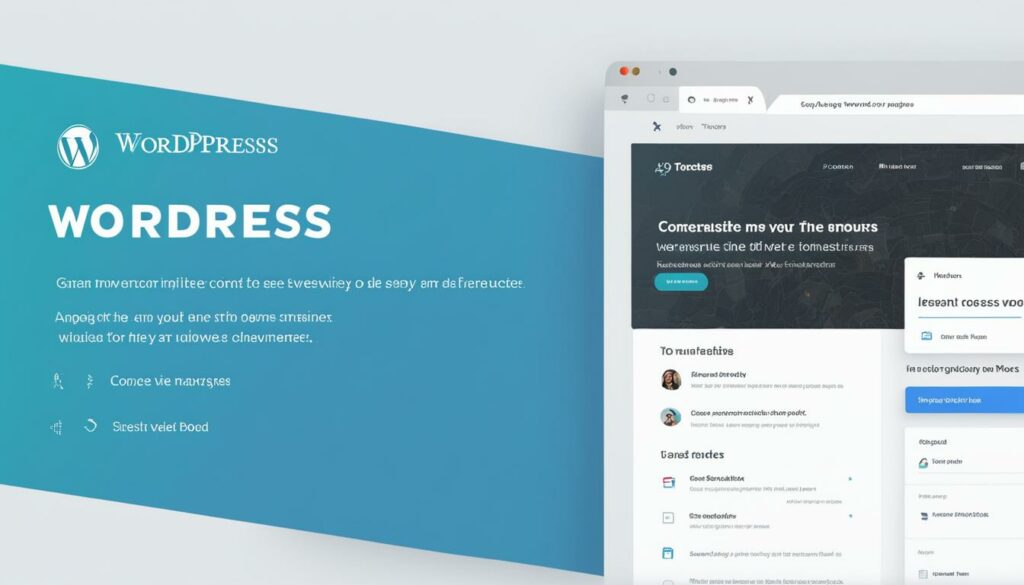Are you reaching your target audience effectively? With the increasing use of mobile devices for online browsing, it’s crucial to ensure that your website is optimized for mobile. Responsive web design is the key to creating mobile-friendly websites that are accessible and user-friendly across various devices. But why is responsive web design so important, and how can it improve your website’s performance and search engine ranking?
Key Takeaways:
- Creating a mobile-friendly website is crucial in today’s digital landscape.
- Responsive web design allows your website to adapt to different screen sizes and devices.
- A mobile-friendly website can improve your search engine ranking.
- Best practices include using a responsive layout, optimizing loading speed, and decluttering your design.
- Regular testing and optimization are essential to ensure a seamless mobile browsing experience.
Why Responsive Web Design is Important for Mobile-Friendly Websites
Responsive web design plays a critical role in creating mobile-friendly websites that adapt seamlessly to any device, be it a desktop computer, smartphone, or tablet. With a responsive layout, your website can scale and adjust to different screen sizes, ensuring a consistent browsing experience for users. This is especially important considering that mobile devices typically have smaller screens compared to desktop computers. A mobile-friendly website incorporating responsive web design principles optimizes its layout and design to fit these smaller screens, providing users with easy navigation and readability.
By implementing responsive web design, your website becomes accessible and user-friendly across a variety of devices. Whether your audience accesses your website on their smartphones during their morning commute or on their tablets while relaxing at home, they can expect a visually appealing and functional experience. Responsive web design eliminates the need for users to manually zoom or scroll sideways to access content, improving their overall satisfaction with your website.
Furthermore, responsive web design is a valuable investment for your business. It saves you from the hassle of maintaining separate mobile and desktop versions of your site, reducing development and maintenance costs. Responsive design also improves your website’s Search Engine Optimization (SEO) efforts. As Google’s algorithms favor mobile-friendly websites, having a responsive design can positively impact your search engine rankings, helping you reach a wider audience and drive more organic traffic.
“A responsive website adapts seamlessly to different devices, providing users with a consistent and enjoyable browsing experience.”
Benefits of Responsive Web Design:
- Improved user experience across devices
- Cost-effective maintenance
- Enhanced SEO performance and organic search visibility
- Increased mobile traffic and conversions
Creating a mobile-friendly website through responsive web design is not just a trend; it’s a necessity in today’s mobile-driven world. It ensures that your audience can access and interact with your website effortlessly, regardless of the device they use. Responsive web design provides a solid foundation for delivering an optimal user experience, boosting your brand credibility and driving business growth.
Best Practices for Creating a Mobile-Friendly Website
To create a mobile-friendly website, it’s important to follow several best practices. By implementing these strategies, you can ensure that your website is optimized for mobile devices and provides a seamless user experience. Let’s explore the key practices that will help you create a mobile-friendly website:
- Responsive Layout: Develop a responsive layout that can adapt to different screen sizes. Use a mobile-responsive theme or template that automatically adjusts the design and layout based on the device being used.
- Optimize Loading Speed: Compress images to reduce file sizes, host videos on third-party platforms, and use HTML5 instead of Adobe Flash. These optimizations will help improve your website’s loading speed on mobile devices.
- Avoid Pop-ups: Avoid using pop-ups, as they can be challenging to view and close on mobile devices. Opt for alternative methods to convey important information or use mobile-friendly pop-up designs.
- Consider Thumb-Friendly Navigation: Change button size and placement to make it easier for users to navigate your site using their thumbs. This enhances user experience and ensures easy access to key website elements.
- Use Readable Fonts and Spaced-out Links: Utilize a large and readable font size, ensuring that text is easily legible on mobile devices. Space out links to prevent accidental clicks and improve navigation.
- Declutter Your Web Design: Simplify your web design to reduce clutter and optimize the visual appeal on mobile devices. Eliminate unnecessary elements and focus on delivering a clean and intuitive user interface.
By adhering to these best practices, you can create a mobile-friendly website that offers an optimal user experience on any device. Remember, a well-optimized mobile site is essential for attracting and retaining mobile users, boosting engagement, and improving your website’s search engine visibility.
Why Mobile Speed and Loading Time Matters
The speed and loading time of your website play a crucial role in ensuring a mobile-friendly experience for your users. Research indicates that users are more likely to abandon a website if it takes more than a few seconds to load. In fact, even a one-second delay can have a significant impact on your conversion rates. To provide a seamless browsing experience for mobile users, it is essential to focus on mobile speed and website loading time optimization.
To optimize your website’s speed, there are several key strategies you can implement:
- Minimize file sizes: Compressing and minimizing the sizes of your website’s files, including CSS, JavaScript, and HTML, can help reduce loading time.
- Compress images: Optimizing and compressing images without compromising quality is crucial for improving mobile speed. Use image compression tools or plugins to reduce file sizes.
- Host videos externally: Rather than hosting videos directly on your website, consider using external platforms like YouTube or Vimeo. This reduces the server load and speeds up mobile loading time.
Testing and Monitoring Mobile Speed
Testing and monitoring your website’s mobile speed is paramount to ensure optimal performance. Tools like BrowserStack SpeedLab provide insights into your website’s loading time on both desktop and mobile devices. Conduct regular tests to identify areas for improvement and make necessary optimizations.

In addition to the strategies mentioned above, optimizing website caching, reducing server response time, and leveraging content delivery networks (CDNs) can also contribute to faster mobile loading times. By prioritizing website speed optimization and mobile-friendly performance, you create a positive user experience that fosters higher engagement and boosts conversions.
Testing and Optimizing Your Mobile-Friendly Website
Testing and optimizing your mobile-friendly website is a crucial step to ensure that it performs well on different devices. By conducting regular mobile testing, you can identify any issues or discrepancies that users may encounter, allowing you to address them promptly.
One recommended approach is to test your website on real mobile devices. This provides a more accurate representation of how your site functions across various screen sizes and resolutions, giving you valuable insights into the user experience. You can borrow smartphones or tablets from friends or colleagues, or use device testing platforms like BrowserStack or Lambdatest.
Additionally, you can utilize Google’s Mobile-Friendly Test, a free tool that evaluates if your website meets the mobile-friendly criteria. Simply enter your website’s URL, and the test will analyze its mobile compatibility, highlighting any areas that need improvement.
To optimize your mobile-friendly website further, ensure that your content is carefully updated for mobile screens. Pay attention to readability by using a legible font size, adjusting line spacing, and using shorter paragraphs. Consider the proper orientation, avoiding horizontal scrolling, and organizing information in a way that flows naturally on mobile devices. This will enhance the user experience and encourage users to engage with your content.
Benefits of Mobile Testing and Optimization
“Testing and optimization are essential for creating a seamless user experience on mobile devices. Without proper testing, you might overlook design flaws or functional issues that can frustrate users and drive them away from your site. By conducting regular mobile testing and optimization, you can ensure that your website is responsive, user-friendly, and optimized for mobile devices, improving engagement, conversions, and ultimately, the success of your online presence.”
Regular testing, along with continuous optimization and updates, will help ensure that your website provides an optimal user experience on mobile devices. By investing time and effort into testing and optimization, you can create a mobile-friendly website that resonates with your audience, drives traffic, and supports your business goals.

| Benefits of Mobile Testing and Optimization | Actions |
|---|---|
| Enhanced User Experience | Regular testing and optimization improve the overall experience for mobile users, resulting in higher engagement and user satisfaction. |
| Reduced Bounce Rate | Optimized mobile websites lead to faster loading times, decreasing the chances of users bouncing off due to slow performance. |
| Improved Conversion Rates | A well-optimized mobile site ensures that users can easily navigate, find information, and complete desired actions, leading to increased conversions. |
| Higher Search Engine Rankings | Search engines prioritize mobile-friendly websites, meaning that optimization can positively impact your search engine rankings. |
The Impact of Mobile-Friendly Websites on SEO
Mobile-friendly websites have revolutionized search engine optimization (SEO), as they play a crucial role in enhancing user experience on mobile devices. With Google’s algorithms prioritizing mobile-responsive sites, having a mobile-friendly website can significantly impact your SEO ranking and overall visibility in search engine results.
By implementing responsive web design and following best practices for mobile optimization, you can improve your website’s chances of ranking higher in search engine results pages (SERPs). Let’s delve into the key factors that highlight the impact of mobile-friendly websites on SEO:
Improved User Experience for Mobile Users
Mobile-friendly websites provide a seamless and user-friendly experience for visitors using smartphones or tablets. The responsive design ensures that your website adjusts effortlessly to different screen sizes, making it easier for users to navigate, read content, and interact with your site. A positive user experience, characterized by fast loading times, easy navigation, and clear content visibility, can boost engagement and reduce bounce rates.
Enhanced SEO Ranking Factors
Google places great importance on mobile-friendly websites when determining search rankings, as they prioritize delivering a superior user experience. Websites that are optimized for mobile devices tend to rank higher in SERPs, gaining increased visibility and attracting more organic traffic. By aligning your website with mobile responsiveness, you strengthen key SEO ranking factors and remain competitive in the online landscape.
Mobile Responsiveness Extends Beyond SEO
The significance of mobile-friendly websites extends beyond SEO. With the growing number of users relying on mobile devices for internet browsing, it has become imperative to cater to this audience. Failing to provide a mobile-responsive experience may result in a high bounce rate, lower conversions, and missed opportunities for user engagement and brand exposure. Investing in mobile responsiveness ensures you remain accessible, relevant, and adaptable in today’s digital world.
To optimize your SEO through mobile responsiveness, follow these best practices:
- Implement responsive web design to ensure your website adapts to various screen sizes and devices.
- Optimize your website’s loading speed by compressing images, minifying code, and utilizing caching techniques.
- Create mobile-friendly content, including legible fonts, well-spaced links, and thumb-friendly button sizes and placements.
- Utilize structured data markup to enhance search engine visibility for mobile users.
By prioritizing mobile-friendliness, you can not only improve your SEO ranking but also provide an excellent browsing experience that keeps visitors engaged and encourages conversions. See the impact of mobile-friendly websites in the table below:
| Benefit | Description |
|---|---|
| Higher SEO Ranking | Google’s algorithms prioritize mobile-friendly websites, leading to improved search engine visibility and ranking. |
| Increased Organic Traffic | Mobile-friendly websites attract more organic traffic from mobile users, expanding your audience reach. |
| Better User Engagement | A seamless mobile browsing experience enhances user engagement, reducing bounce rates and increasing time spent on your site. |
| Improved Conversions | Mobile-friendly websites inspire trust and facilitate smooth navigation, increasing the likelihood of conversions. |

By understanding the impact of mobile-friendly websites on SEO and implementing the necessary optimizations, you can leverage the power of mobile responsiveness to attract and retain a wider audience, improve your search rankings, and drive meaningful results for your online presence.
Conclusion
Creating a mobile-friendly website is crucial in today’s digital landscape. With the increasing use of mobile devices to access the internet, it’s essential to ensure that your website is accessible and user-friendly across different screen sizes and devices.
By implementing responsive web design, optimizing website speed, and following best practices for mobile optimization, you can create a mobile-friendly website that provides a seamless browsing experience for your users. Responsive web design allows your site to adjust and adapt to different screen sizes and devices, ensuring that it looks and functions well regardless of the device being used. Optimizing your website’s speed and following mobile optimization best practices further enhance the user experience and improve your site’s performance.
A mobile-friendly website not only enhances user experience but also has potential benefits for your business. It can lead to increased user engagement, improved SEO ranking, and higher conversions. With more people accessing the internet through mobile devices, having a mobile-friendly website can help you reach a larger audience and stay ahead of the competition.
Investing time and effort into making your website mobile-friendly is crucial for meeting the evolving needs of your audience in the mobile era. Stay up to date with the latest trends and technologies in mobile optimization to ensure that your website remains accessible, user-friendly, and optimized for different devices. By prioritizing mobile-friendly design, you can create a website that delivers a seamless browsing experience and drives success for your business.
FAQ
Q: Why is responsive web design important for mobile-friendly websites?
A: Responsive web design ensures that your website looks and functions well on any device, providing users with a seamless browsing experience. It allows your site to adapt to different screen sizes and devices, making it accessible and user-friendly across a variety of platforms.
Q: What are the best practices for creating a mobile-friendly website?
A: Some best practices for creating a mobile-friendly website include using a mobile-responsive theme or template, optimizing loading speed, avoiding pop-ups, changing button size and placement for easier navigation, using readable fonts, and decluttering your design for a seamless user experience.
Q: Why does mobile speed and loading time matter?
A: Mobile speed and loading time are crucial factors for creating a mobile-friendly experience. Research shows that users are more likely to abandon a website if it takes too long to load, and a one-second delay can significantly impact conversion rates. Optimizing your website’s speed ensures a fast and responsive browsing experience for mobile users.
Q: How do I test and optimize my mobile-friendly website?
A: It’s recommended to regularly test your website on real mobile devices to identify any issues or discrepancies that users may encounter. You can also use tools like Google’s Mobile-Friendly Test to check if your website meets the mobile-friendly criteria. Additionally, you should carefully update your website’s content for mobile screens, ensuring readability and proper orientation.
Q: What impact do mobile-friendly websites have on SEO?
A: Mobile-friendly websites have a significant impact on search engine optimization (SEO). Google’s algorithms prioritize mobile-friendly sites, as they provide a better user experience for mobile users. Having a mobile-friendly website can improve your SEO ranking and visibility in search engine results, driving more organic traffic and increasing user engagement.











